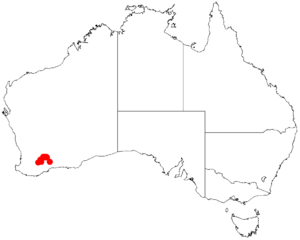Acacia obesa facts for kids
Quick facts for kids Acacia obesa |
|
|---|---|
| Conservation status | |
| Scientific classification | |
| Genus: |
Acacia
|
| Species: |
obesa
|
 |
|
| Occurrence data from AVH | |
Acacia obesa is a type of shrub that belongs to the Acacia family. It is found only in a small part of Western Australia. This plant is a low-growing shrub that spreads out.
What it Looks Like
This shrub usually grows to be about 0.3 to 0.6 meters (1 to 2 feet) tall. Its branches are round and get thinner towards the ends. They can also be quite hairy.
Like many Acacia plants, Acacia obesa has special leaf-like parts called phyllodes. These are not true leaves. The phyllodes are thick and smooth. They are shaped like cylinders and are often slightly curved. Sometimes, they can be straight. Each phyllode is about 1 to 2.5 centimeters long. They are about 1.2 to 1.75 millimeters wide. You can see 12 to 16 fine, raised lines running along them.
The plant blooms, or flowers, from July to September. When it flowers, it produces bright yellow flowers.
Its Name and History
Scientists Richard Sumner Cowan and Bruce Maslin first officially described this plant in 1995. They gave it the name Acacia obesa.
Later, in 2003, another botanist named Leslie Pedley changed its name to Racosperma obesum. However, in 2014, it was moved back to the Acacia group. So, its official name is once again Acacia obesa.
Where it Grows
Acacia obesa is found in a specific area of the southern Wheatbelt region. This region is in Western Australia. It grows best in sandy or gravelly loam soils. These are soils that have a mix of sand, silt, and clay, often with small stones.
This shrub does not grow in many places. It is only found in an area between three towns: Lake Grace, Lake King, and Hyden. You can usually find it growing in open scrublands. It also grows in open heathlands or low, open woodlands.


